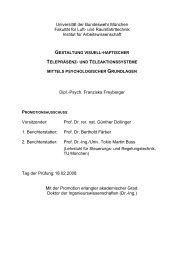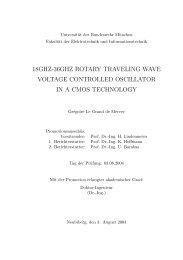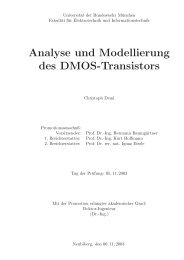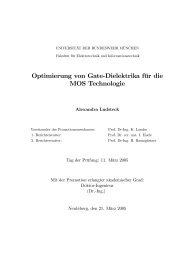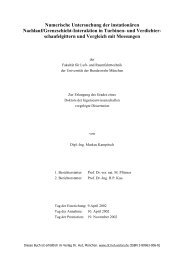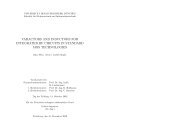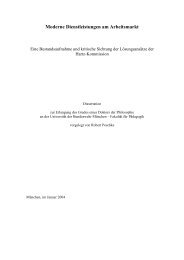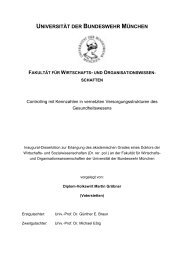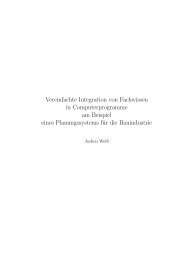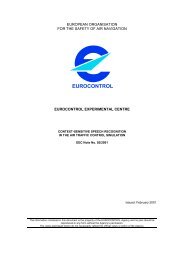Precise Orbit Determination of Global Navigation Satellite System of ...
Precise Orbit Determination of Global Navigation Satellite System of ...
Precise Orbit Determination of Global Navigation Satellite System of ...
Create successful ePaper yourself
Turn your PDF publications into a flip-book with our unique Google optimized e-Paper software.
Chapter 1 Introduction<br />
1.2 Development Phase<br />
GNSS-2/Galileo system will be developed in the period from 2000 to 2008, building on the experience acquired<br />
from GNSS-1.<br />
The time schedule for the different steps can be summarized as follows: (Commission Communication to the<br />
European Parliament and the Council on Galileo, 2000)<br />
Development and Validation Phase 2001 to 2005<br />
Deployment Phase 2006 to 2007<br />
Start <strong>of</strong> Operation 2008<br />
1.3 <strong>Orbit</strong> <strong>Determination</strong> <strong>of</strong> GNSS-2/Galileo<br />
In the early study phase, the typical space segment <strong>of</strong> GNSS-2/Galileo system was composed <strong>of</strong> inclined<br />
geosynchronous (IGSO), geostationary (GEO) and medium earth orbit (MEO) satellites. Now the space segment<br />
<strong>of</strong> Galileo system is composed <strong>of</strong> 30 MEO satellites or MEO + GEO satellites. According to the document <strong>of</strong> EU<br />
Commission Communication to the European Parliament and the Council on Galileo 2000, the advantage <strong>of</strong> the<br />
system using such satellites is more uniform in performance both in terms <strong>of</strong> accuracy and availability and<br />
greater robustness in crippled mode. With this new satellite navigation system under control <strong>of</strong> civilian<br />
institutions, the precise navigation and positioning with accuracy <strong>of</strong> at least 10 meters without differential<br />
techniques may be achieved. Therefore high precision orbit determination is required for successful applications<br />
<strong>of</strong> GNSS-2/Galileo system with this accuracy level.<br />
There are some new problems for orbit determination <strong>of</strong> GNSS-2 satellites. For example, due to high altitude <strong>of</strong><br />
IGSO and GEO satellites, the geometrical distribution <strong>of</strong> tracking stations will have a greater influence on the<br />
accuracy <strong>of</strong> orbit determination than any other earth satellites, the distances between the satellites and tracking<br />
stations will change slowly as satellites move, which leads to some problems in the solution <strong>of</strong> observation<br />
equation, because there are no big differences for observations measured in several minutes. In other words,<br />
more observations in a short time will not contribute to improve the accuracy <strong>of</strong> orbit determination, and when<br />
using Doppler-based methods it also does not enhance the accuracy <strong>of</strong> orbit determination because the Doppler<br />
effect will not be significantly sensitive to slow changing <strong>of</strong> the range rate.<br />
Until now the actual accuracy <strong>of</strong> geostationary orbit determination is in kilometers. The precise orbit<br />
determination <strong>of</strong> a GNSS-2 satellite with comparable accuracy to a GPS satellite, therefore, is a great challenge.<br />
In order to achieve highly accurate orbit determination <strong>of</strong> GNSS-2 satellites, the satellite tracking station<br />
distribution and related data processing methods should be carefully chosen to satisfy the accuracy requirement<br />
<strong>of</strong> GNSS-2 system.<br />
The tracking systems <strong>of</strong> orbit determination can be classified as two major types: ground-based tracking systems<br />
such as S-Band and <strong>Satellite</strong> Laser Ranging (SLR) and space-borne tracking systems, for examples, DORIS and<br />
PRARE. There are two major kinds <strong>of</strong> observations for orbit determination: optical and radio microwaves. Basic<br />
optical observations are directions and angles. The microwave observation may consist <strong>of</strong> ranges, range rates<br />
(Doppler), and carrier phases.<br />
In the dissertation, the current systems <strong>of</strong> orbit determination using ranges, range rates (Doppler) and carrier<br />
phases will be discussed and evaluated. The focus is on ground orbit determination methods. In Chapter 2, the<br />
basic observations <strong>of</strong> orbit determination are discussed; in Chapter 3 current systems used for various orbit<br />
determination applications are evaluated; in Chapter 4 major sources <strong>of</strong> observation errors are analyzed; in<br />
Chapter 5 perturbations on IGSO, GEO and MEO are modeled and estimated; in Chapter 6 major algorithms <strong>of</strong><br />
orbit determination <strong>of</strong> IGSO, GEO and MEO, for examples, dynamic, reduced dynamic and kinematic methods<br />
are developed and discussed; in Chapter 7 high accuracy <strong>of</strong> IGSO and GEO orbit determination using carrier<br />
phase observation are discussed; in Chapter 8 a serious problem <strong>of</strong> GEO orbit determination during satellite<br />
maneuvers is presented and solved, and finally the simulation results <strong>of</strong> a possible satellite tracking system <strong>of</strong><br />
GNSS-2 are presented in Chapter 9.<br />
IGSO, GEO and MEO satellites are all possible candidates for a GNSS-2/Galileo system. MEO satellites are<br />
actually the same type as GPS/GLONASS satellites, therefore in the dissertation, my focus is on IGSO and GEO<br />
satellites, i.e. precise orbit determination <strong>of</strong> IGSO and GEO satellites, including special situation during GEO<br />
satellite maneuvers.<br />
2



